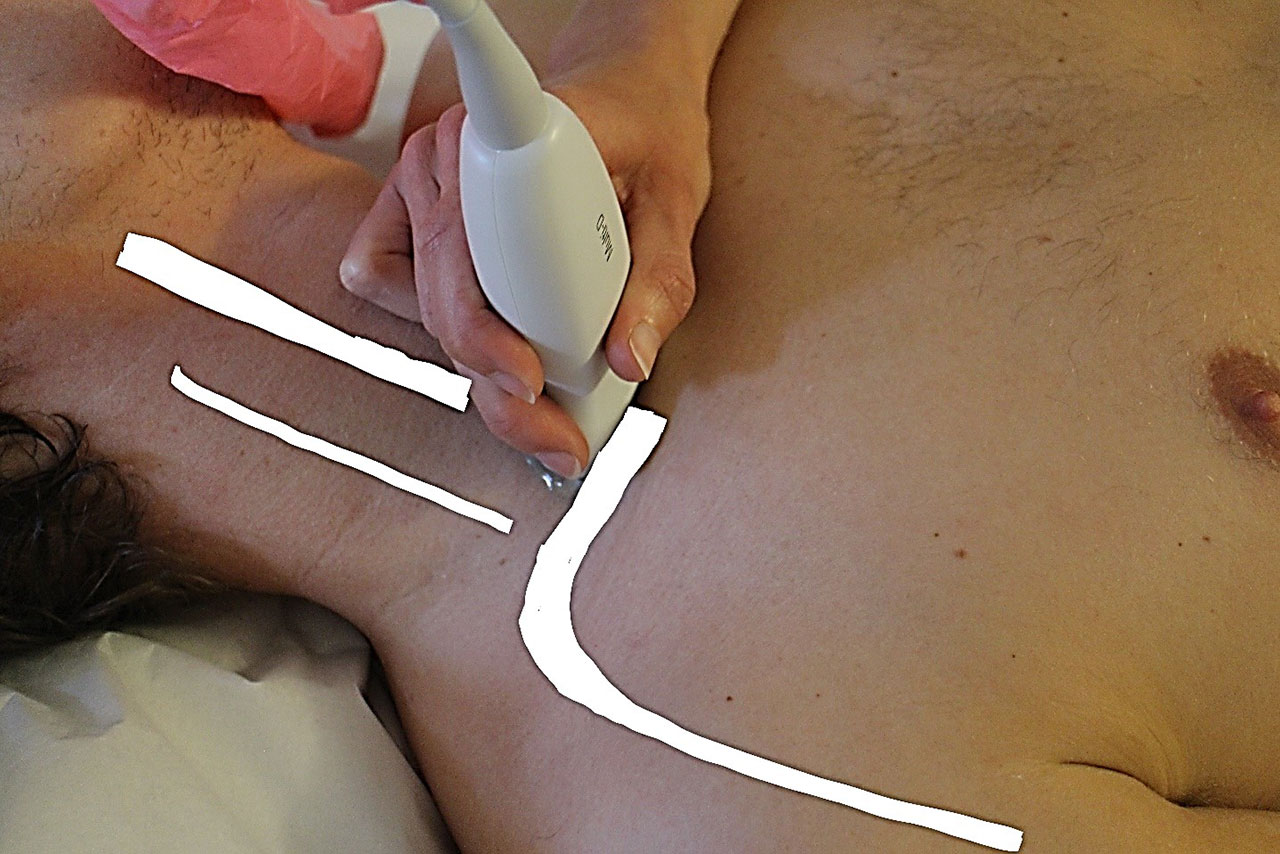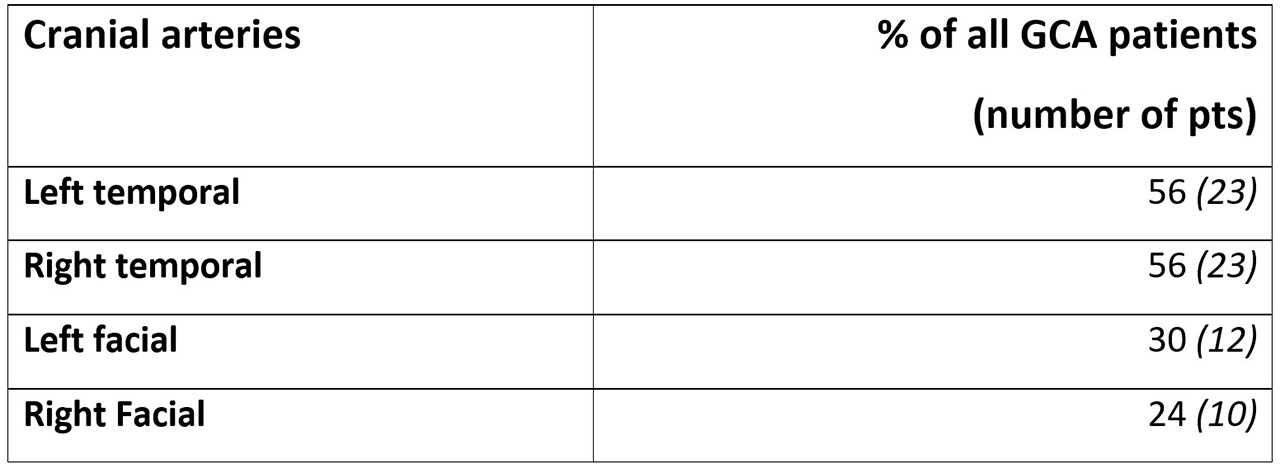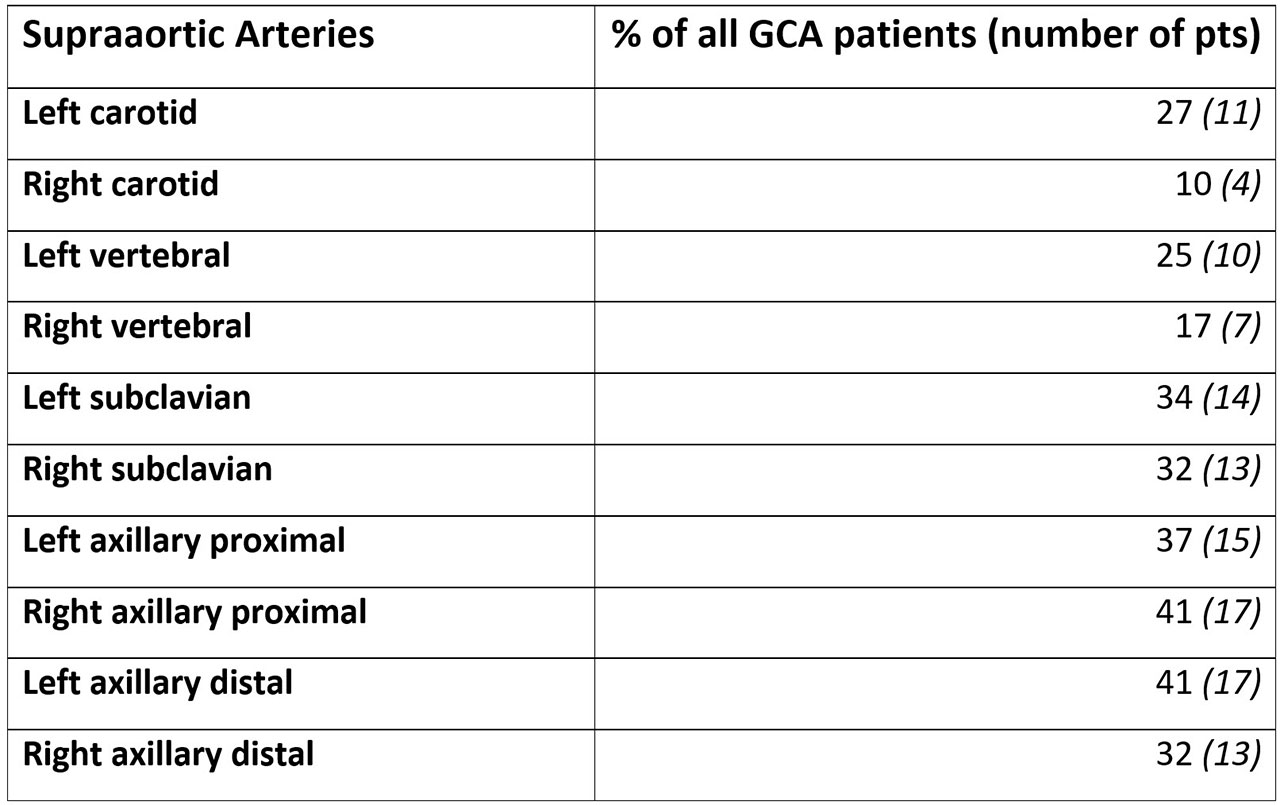Session Information
Date: Tuesday, November 12, 2019
Title: Vasculitis – Non-ANCA-Associated & Related Disorders Poster III: Giant Cell Arteritis
Session Type: Poster Session (Tuesday)
Session Time: 9:00AM-11:00AM
Background/Purpose: Giant cell arteritis (GCA) affects both the cranial and large vessels. Ultrasonographic studies have reported that the incidence of large vessel vasculitis (LVV) in patients with GCA varies from 30% to 55%. The aim of this study was to investigate the rate of LVV in patients with GCA by using the new anteromedial approach to examine the large supraaortic vessels in addition to the cranial arteries.
Methods: Patients with new-onset GCA referred to the Department of Rheumatology, Martina Hansens Hospital in Bærum, Norway between September 2017 and April 2019 were included. The diagnosis was based on typical clinical manifestations and ultrasound findings. All the patients were scanned by ultrasound using the anteromedial approach for the supraaortic vessels (carotid, vertebral, subclavian, axillary proximally and distally), in addition to the examination of the cranial vessels (temporal, facial). The anteromedial approach consists of a continuous ultrasound evaluation of the large supraaortic vessels with the patient in a supine position (figure 1). The examination was performed with a General Electric S8 ultrasound machine with a 9-12 Mhz linear probe for the large vessels and an 18 Mhz hockey stick probe for the cranial arteries. The age, gender, CRP and the distribution of vasculitis in the vessels were recorded. The cut-off for vasculitis of the large vessels was set at 1 mm (homogeneous, hypoechoic or isoechoic thickness of the intima-media complex).
Results: Forty-one patients, 30 (73%) females, and 11 (27%) males were diagnosed with GCA during the recruitment period. The mean age was 71 years (95% CI (67-74)). Mean CRP was 79.6 mg/dl (95% CI (63-96)). Of the 41 GCA patients, 10 patients (24 %) had cranial GCA only, 12 patients (30 %) had LVV only and 19 patients (46 %) had both cranial and LVV GCA. The temporal arteries were the most frequently inflamed in 56 % of the patients, followed by the facial artery(left 29% and right 24%). The large supraaortic vessels mostly inflamed were the right proximal and left distal axillary (41 %), the left proximal axillary (37%) and the subclavian (left 34% and right 32%) (tables 1 and 2).
Conclusion: The anteromedial ultrasound examination revealed inflammation of the large supraaortic vessels in 76 % of the GCA patients. This indicates that the involvement of supraaortic arteries is more common in GCA than previously reported. Possible explanations may include the visualization of all the supraaortic arteries and both the upper and lower arterial wall when using the anteromedial ultrasound scanning.
To cite this abstract in AMA style:
Bull Haaversen A, Diamantopoulos A. The Anteromedial Ultrasound Examination of the Large Supraaortic Vessels Identifies Higher Rates of Large Vessel Involvement Than Previous Reported in Patients with Giant Cell Arteritis [abstract]. Arthritis Rheumatol. 2019; 71 (suppl 10). https://acrabstracts.org/abstract/the-anteromedial-ultrasound-examination-of-the-large-supraaortic-vessels-identifies-higher-rates-of-large-vessel-involvement-than-previous-reported-in-patients-with-giant-cell-arteritis/. Accessed .« Back to 2019 ACR/ARP Annual Meeting
ACR Meeting Abstracts - https://acrabstracts.org/abstract/the-anteromedial-ultrasound-examination-of-the-large-supraaortic-vessels-identifies-higher-rates-of-large-vessel-involvement-than-previous-reported-in-patients-with-giant-cell-arteritis/



